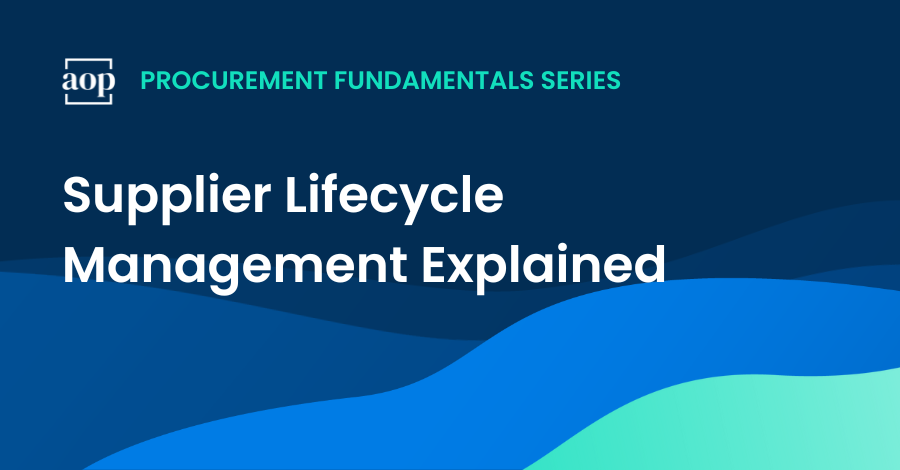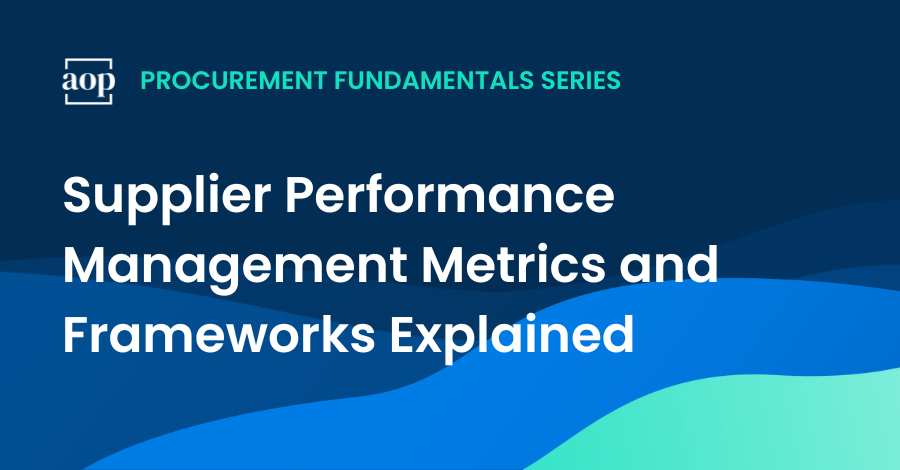
A typical enterprise-scale business collaborates with thousands or even tens of thousands of suppliers. This volume of relationships requires procurement teams to put emphasis on managing suppliers in an efficient and methodological way.
Supplier lifecycle management (SLM) is an approach that treats supplier relationships in a consistent way from start to finish. Let’s review the core concepts and best practices you need to know to master your supplier lifecycle processes.

What is Supplier Lifecycle Management?
Supplier lifecycle management refers to the systematic process of managing supplier interactions in order to maximize value, ensure compliance, and mitigate risks throughout the partnership’s lifetime.
SLM involves managing every phase of a supplier’s common path with your organization from the first interactions to the eventual end of the commercial relationship.
Each company will have their own supplier lifecycle steps, tasks and procedures. These typically involve activities such as:
- Onboarding: Bringing new suppliers into your systems and processes effectively.
- Supplier information management: Maintaining a reliable source of truth for all supplier-related master data.
- Performance management: Monitoring and enhancing supplier performance.
- Supplier risk management: Evaluation and monitoring of key risk factors in the supply base.
- Offboarding or rationalization: Transitioning suppliers out when necessary.
One core goal of supplier lifecycle management is that you can oversee a large portfolio of suppliers within a category or business unit in a consistent and effective way. This requires a lot of planning and coordination.
Why is supplier lifecycle management important?
Modern procurement teams need to onboard hundreds of new suppliers each year and make sure supplier performance is managed consistently across different categories of spend. According to the Hackett Group, the average company has 3,000 suppliers per US $1 billion in spend.
It’s clear to most high-performing companies that supplier relationships have a direct impact on commercial performance. In their Supplier Relationship Management guidelines, healthcare technology provider Philips describes how “Making the business relationship with our suppliers efficient and effective is a key to our future success.”
7 Step Supplier Lifecycle Management Process You Can Follow
There is no set rulebook on SLM. Instead, you can say supplier lifecycle management has similarities with the agile method of product management that segments projects into manageable phases, focusing on continuous improvement. From this perspective, you can build your own supplier lifecycle management process in seven clear steps.
1. Supplier onboarding
Supplier onboarding typically starts with the search for and identification of potential suppliers. This may involve an RFx or other type of formal invitation to be considered as a potential supplier of goods or services.
2. Registration, Assessment, and Approval
Once you have chosen your new supplier(s), it’s time for registration, assessment, and approval. Start by registering potential suppliers in your eSourcing solution or supplier database. Gather all of the information necessary to assess their capabilities and compliance. Ensure you have a rigorous evaluation process to approve only those who align with your strategic goals and quality standards.
3. Supplier Segmentation
Once suppliers are onboarded, segment them based on factors like spend, risk, and strategic importance. Segmentation allows you to tailor your management approach, focusing resources on high-impact suppliers and maintaining efficient oversight of others.
The Kraljic matrix is often used as inspiration for supplier segmentation. Make sure you have a segmentation model that fits your organization’s unique needs and requirements.
4. Performance Evaluation
Regularly evaluate supplier performance by setting clear KPIs and metrics. Focus on delivery times, quality, and cost efficiency. Implement automated systems to continuously monitor these metrics to quickly identify areas for improvement and make data-driven decisions.
5. Risk Monitoring
Implement robust monitoring systems to manage potential supplier risks. Keep an eye on financial stability, compliance, and operational risks. Develop contingency plans for each supplier to mitigate disruptions, ensuring your supply chain remains resilient.
6. Supplier Development
Invest in supplier development to improve capabilities and foster innovation with your suppliers. Collaborate with key suppliers on improvement initiatives and provide constructive feedback. By investing in their growth, you can strengthen your partnerships and drive mutual success.
7. Supplier Rationalization
It’s only realistic that most supplier relationships have a natural endpoint. Regularly assess your supplier base to identify redundancies. Streamline your portfolio to reduce complexity and enhance efficiency. Focus on building strategic partnerships with suppliers who add the most value.
By following these steps, you can create a robust supplier lifecycle management process that improves performance, reduces risks, and supports your strategic objectives.
Keeping Track of Supplier Information and Data
Most procurement teams are responsible for collecting and analyzing a large amount of information and data related to suppliers.
You may have a source-to-contract suite or other supplier information repository. In other cases, you may simply have a well-maintained master data record on supplier data in your ERP system. Either way, there are a number of key points to remember when managing your supplier data across the timespan of a partnership.
Establish Data Standards
Define clear data standards and formats for all supplier information. This includes naming conventions, data fields, and categorization. Consistent data entry ensures accuracy and reduces errors, making it easier to analyze and share information wherever it is stored.
Implement Data Governance
Set up a data governance framework to oversee supplier data management processes. Assign roles and responsibilities for data entry, maintenance, and quality control. Regular audits can ensure compliance with data standards and address any discrepancies.
Automate Data Updates
Leverage automation tools to keep supplier data current. Automated workflows can prompt suppliers to update their information regularly and notify you of any changes. This reduces manual effort and ensures data remains up-to-date. You can also consider integrating third party supplier data sources to evaluate key aspects such as sustainability or risk factors.
Ensure Data Security
Managing supplier data requires a high level of confidentiality and trust. Protect your supplier data with robust security measures. Implement encryption, secure access controls, and regular security audits. Ensure that only authorized personnel have access to sensitive information, reducing the risk of data breaches.
Facilitate Data Sharing
Create dashboards and reports in your spend analysis solution to share relevant supplier data with stakeholders – and why not even the suppliers themselves! This transparency helps to align supplier performance with organizational goals and fosters collaborative relationships. Ensure the data shared is accurate and up-to-date to support informed decision-making.
Well maintained and reliable supplier information is the unsung hero of supplier lifecycle management. Once you have data you can trust, you can build the basis for long-lasting relationships.
SLM Starts and Ends with a Focus on Continuous Improvement
Ultimately, continuous improvement should be at the heart of your supplier lifecycle management program. You can always improve key supplier engagement processes by putting more time and effort into them.
Incorporate feedback loops to refine practices within the procurement team and with other key stakeholders. Also, regularly solicit input from suppliers and stakeholders to identify areas for improvement.
It is also wise to benchmark against industry standards to measure and evaluate performance. Use these benchmarks to pinpoint strengths and weaknesses, guiding process improvements.
Invest in training and development for your team. Equip them with the skills and knowledge needed to excel in managing complex supplier relationships, ensuring your organization remains competitive.
Bottom Line on Supplier Lifecycle Management
Well executed supplier lifecycle management processes help you organize even the largest portfolios of suppliers transparently and effectively.
By implementing best practices and maintaining a focus on continuous improvement you can both optimize supplier relationships and maintain a resilient supply chain.






